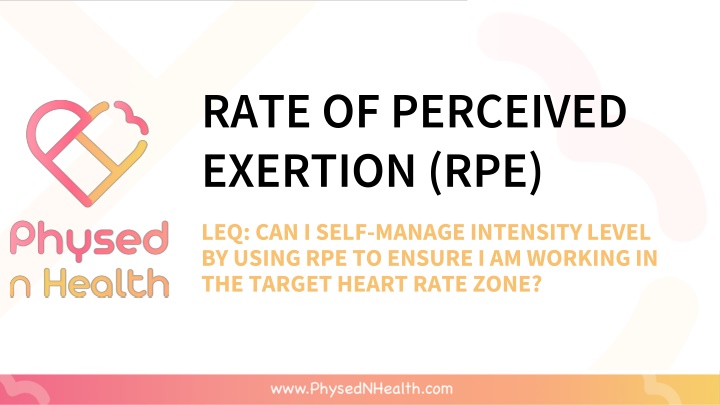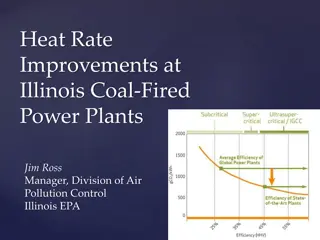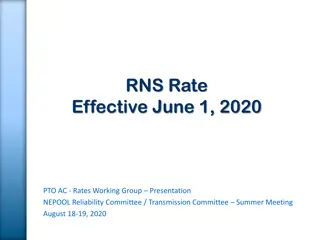
Rate of Perceived Exertion for Effective Exercise Management
Learn how to self-manage exercise intensity using the Rate of Perceived Exertion (RPE) scale to ensure you are working in the target heart rate zone. Discover the different levels of perceived exertion, identify physical, mental, emotional, and social barriers to exercise, and modify movements for optimal participation. Utilize the talk test to monitor exercise intensity and attain your fitness goals safely and effectively.
Download Presentation

Please find below an Image/Link to download the presentation.
The content on the website is provided AS IS for your information and personal use only. It may not be sold, licensed, or shared on other websites without obtaining consent from the author. If you encounter any issues during the download, it is possible that the publisher has removed the file from their server.
You are allowed to download the files provided on this website for personal or commercial use, subject to the condition that they are used lawfully. All files are the property of their respective owners.
The content on the website is provided AS IS for your information and personal use only. It may not be sold, licensed, or shared on other websites without obtaining consent from the author.
E N D
Presentation Transcript
RATE OF PERCEIVED EXERTION (RPE) LEQ: CAN I SELF-MANAGE INTENSITY LEVEL BY USING RPE TO ENSURE I AM WORKING IN THE TARGET HEART RATE ZONE?
SELF-MANAGEMENT What are my physical barriers for exercise? What are my mental barriers for exercise? What are my emotional barriers for exercise? What are my social barriers for exercise? How can I modify movement to experience success and desire to fully participate? 1. 2. 3. 4. 5.
RATE OF PERCEIVED EXERTION A scale to help monitor exercise intensity to make sure you re working at a pace that is challenging enough to help you reach your goals, but not so hard you risk your health and safety. Often abbreviated as RPE, the scale helps you evaluate effort through comfort level, heart rate, breath rate, and sweat.
LEVELS OF PERCEIVED EXERTION Level 0: I m sleeping, lying on a beach, or meditating. Level 1: I'm watching TV, reading, or playing on my phone. Level 2: I'm standing or taking a stroll through the halls at school. Level 3: I'm walking but comfortable. I could go at this pace all day. Level 4: I'm sweating while moving but feel good and can havea conversation. Level 5: I'm just above comfortable, sweating more and can still talk easily. Level 6: I can still talk but am slightly breathless. Maybe a sentence or two. Level 7: I can still talk, but I don't really want to. I'm sweating everywhere! Level 8: I can say a word or two and can only keep this pace for a short time. Level 9: I am probably going to die. I think I might puke. Am I still breathing? Level 10: I am dead.
RATE OF PERCEIVED EXERTION When exercising, use the talk test to monitor intensity by focusing on your breath and ability to talk. The harder you work, the more breathless you become, making it harder to maintain a conversation. Determine if you are working at a low, moderate, or high intensity level to gauge your workouts using the RPE scale in combination with your knowledge of target heart rate zone.
REFLECTION 1. WHAT IS RATE OF PERCEIVED EXERTION? 2. HOW CAN YOU USE IT DURING EXERCISE? 3. HOW CAN YOU USE THE TALK TEST TO MONITOR EXERCISE INTENSITY?
Rate of Perceived Exertion & Target Heart Rate Training Zones LEVEL EFFORT TALK TEST 10 Maximum Intensity 9 Extreme Intensity 7-8 Vigorous Intensity 4-6 Moderate Intensity 2-3 Low Intensity 0-1 Light Intensity THZ 95-100% MHR Competition & PURPOSE Impossible to maintain for more than 30 seconds. Out of breath & unable to talk. Max Testing VO2 Max & Speed Training HIIT & Anaerobic Training Endurance & Aerobic Training Active Recovery, Warm-Up Sedentary Activities 85-95% MHR Difficult to maintain for more than a minute. Breathless & can barely say a word. 75-85% MHR Uncomfortable effort, close to breathless. Can respond with one or two words. 60-75% MHR Sweating with increased respiration. Can respond in sentences. 50-60% MHR Can maintain this effort for hours. Easy to breathe and have a conversation. <50% MHR Minimal change in respiration, heart rate, & perspiration. No impact on talking ability.
RATE OF PERCEIVED EXERTION MOST WORKOUTS SHOULD BE AROUND A 5-6. DURING INTERVAL TRAINING, RECOVERY BLOCKS SHOULD BE A 4-5 AND INTENSITY EFFORTS 8-9. WORKING AT A LEVEL 10 ISN T NECESSARY AND NOT RECOMMENDED FOR MOST WORKOUTS. FOR LONGER, SLOWER WORKOUTS, KEEP RPE AT LEVEL 5 OR LOWER. VARY WORKOUT INTENSITY THROUGHOUT THE WEEK FOR OPTIMAL TRAINING AND BENEFITS.
MEASURE EXERCISE INTENSITY RESPIRATION (breathing) HEART RATE (pulse) PERSPIRATION (sweat)
RATE OF PERCEIVED EXERTION (Level 1-10) Walk between classes Active sports practice HIIT workout 20 min yoga flow Running for 30 mins Vacuuming the house Hiking on trails Dancing at a party Sprinting from danger Lower body strength workout How would you rate the following physical activities based on the RPE scale and the effort you would bring to the movement? Compare your list with a partner or small group and discuss reasons for differences in responses.
LOW INTENSITY ACTIVITY Level 3-5 on the Perceived Exertion Scale. Work at this intensity when warming up for a training session or performing a long workout, like a bike ride, swim, walk, hike, or run. Work at this intensity if you take walks throughout the day or go outside to play and get fresh air. Think of this as 60 minutes of physical activity per day. Participate in movement at this intensity 6-7 days a week.
MODERATE INTENSITY Level 5-6 on the RPE scale Participate at this level about 2-3 times a week. Think of performing an aerobic workout where you can respond in fragmented sentences, your heart rate and respiration are elevated, and you are sweating.
HIGH INTENSITY Level 8-9 on the Rate of Perceived Exertion Scale A level you can only work at for short periods of time. You might work at this intensity during high-intensity interval training (HIIT). Participate in 1-2 workouts at this intensity a week with recovery days in between.
REFLECTION 1. WHAT RPE LEVELS ARE APPROPRIATE FOR AEROBIC WORKOUTS WITH THE INTENT OF IMPROVING CARDIO-RESPIRATORY ENDURANCE? WHY? 2. WHAT RPE LEVELS ARE APPROPRIATE FOR ANAEROBIC WORKOUT EFFORTS WITH THE INTENT OF IMPROVING SPEED, POWER, AND CARDIO- RESPIRATORY STRENGTH? WHY? 3. WHAT RPE LEVELS ARE APPROPRIATE FOR ACTIVE RECOVERY EFFORTS OR WORKOUTS? WHY? 4. WHEN WOULD IT BE APPROPRIATE TO WORK AT A LEVEL 9 OR 10 ON THE RPE SCALE? WHY?
FITT & RATE OF PERCEIVED EXERTION FREQUENCY 6-7 Days a Week INTENSITY Low RPE TIME TYPE 3-5 60+ Mins Walk, Active Play, Lifetime Activities Run, Box, Active Sports, Cycling HIIT, Game, Match, Race, Competition 2-3 Days a Week Moderate 5-7 30-45 Mins 1-2 Days a Week High 7-9 20-30 Mins
REFLECTION 1. HOW MANY DAYS A WEEK SHOULD YOU PARTICIPATE IN LEVEL 3-5 PHYSICAL ACTIVITIES FOR CARDIO- RESPIRATORY ENDURANCE? PROVIDE 2-3 EXAMPLES OF LOW INTENSITY ACTIVITIES. 2. HOW MANY DAYS A WEEK SHOULD YOU PARTICIPATE IN LEVEL 5-7 PHYSICAL ACTIVITIES FOR CARDIO- RESPIRATORY ENDURANCE? PROVIDE 2-3 EXAMPLES OF MODERATE INTENSITY ACTIVITIES. 3. HOW MANY DAYS A WEEK SHOULD YOU PARTICIPATE IN LEVEL 7-9 PHYSICAL ACTIVITIES FOR CARDIO- RESPIRATORY ENDURANCE? PROVIDE 2-3 EXAMPLES OF HIGH INTENSITY ACTIVITIES.
THINK, PAIR, SHARE According to the Rate of Perceived Exertion scale, what level would you rank the activity? Why? Analyze your effort, duration, and pace of movement used to justify if the activity was low, moderate, or high intensity? Explain. How can knowledge of the RPE scale be used to monitor exercise intensity and target heart rate zone (THZ)?
RATE OF PERCEIVED EXERTION (RPE) LEARNING ASSIGNMENT
RPE QUIZ LEARNING ASSESSMENT






















